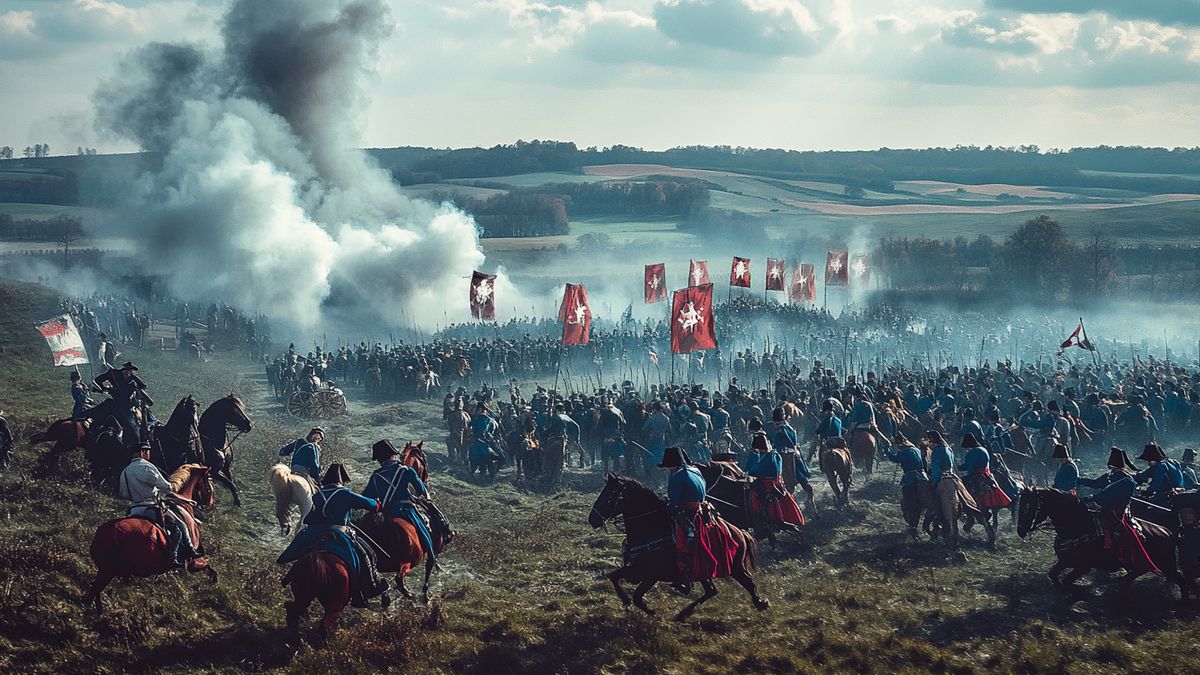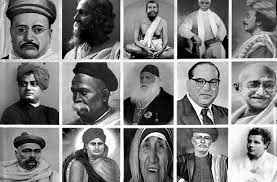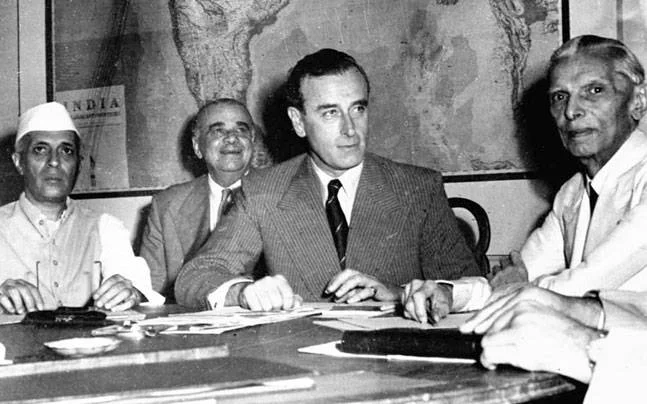- Courses
- GS Full Course 1 Year
- GS Full Course 2 Year
- GS Full Course 3 Year
- GS Full Course Till Selection
- Answer Alpha: Mains 2025 Mentorship
- MEP (Mains Enrichment Programme) Data, Facts
- Essay Target – 150+ Marks
- Online Program
- GS Recorded Course
- Polity
- Geography
- Economy
- Ancient, Medieval and Art & Culture AMAC
- Modern India, Post Independence & World History
- Environment
- Governance
- Science & Technology
- International Relations and Internal Security
- Disaster Management
- Ethics
- NCERT Current Affairs
- Indian Society and Social Issue
- NCERT- Science and Technology
- NCERT - Geography
- NCERT - Ancient History
- NCERT- World History
- NCERT Modern History
- CSAT
- 5 LAYERED ARJUNA Mentorship
- Public Administration Optional
- ABOUT US
- OUR TOPPERS
- TEST SERIES
- FREE STUDY MATERIAL
- VIDEOS
- CONTACT US
Salient aspects of Indian art forms- DANCES
Salient aspects of Indian art forms- DANCES
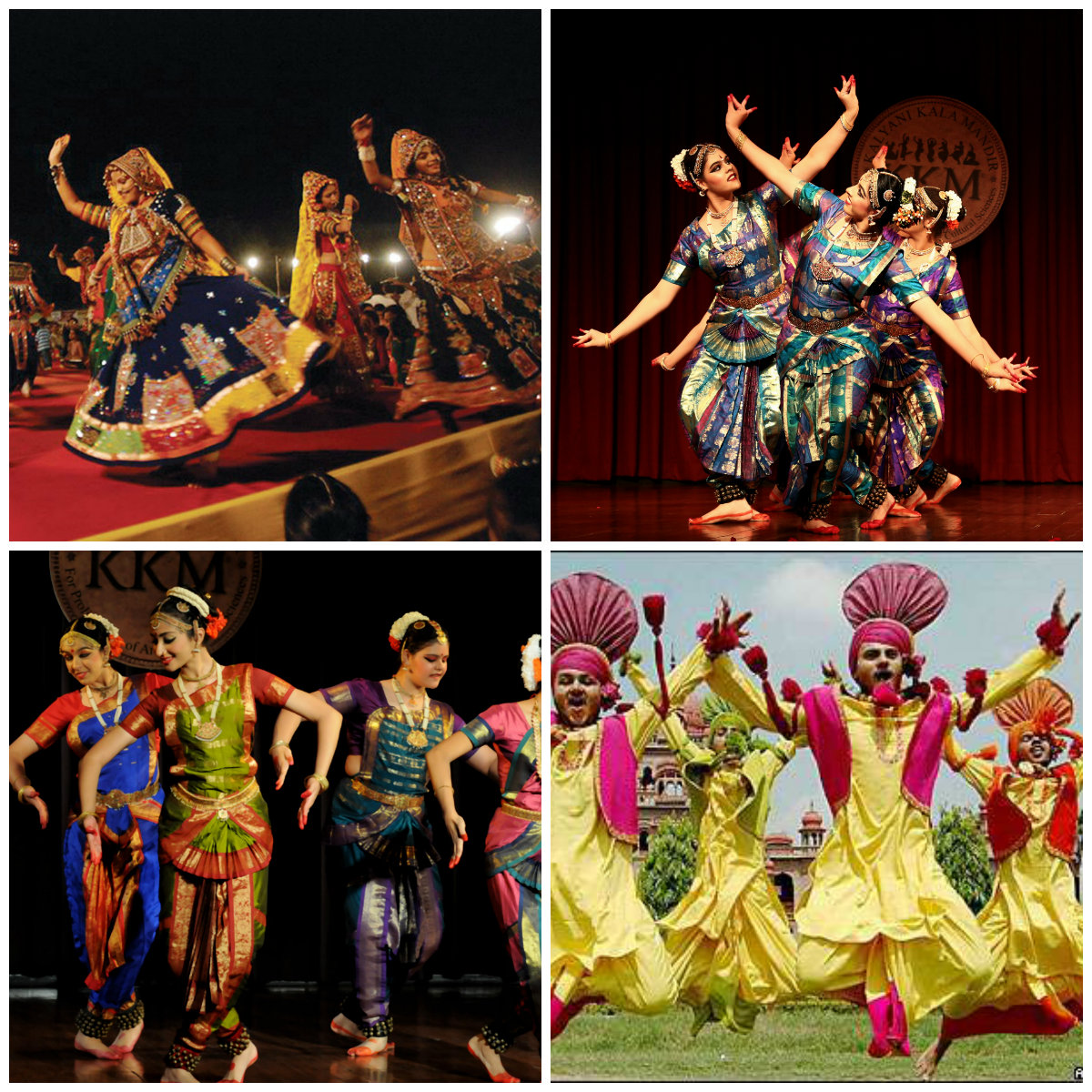
Salient Aspects of Indian Art Forms- DANCES
Features of Indian Classical Dance
- Sthayibhavas: It has various postures, the mudras or the hand movements depicting particular meaning. structured around the nine rasas or emotions. These primary emotions are also referred as the Sthayibhavas. They are as follows:
• Adbhuta - Wonder
• Karuna - Compassion
• Shanta - Tranquility
• Veera - Heroism
• Roudra - Anger
• Bhayanaka - Terror
• Bheebatsa - Disgust
• Shringara - Love
• Hasya - Mirth
- Abhinaya: Abhinaya is the art of expression in Indian classical dances. It includes facial expressions, hand gestures, and body language. It is an essential feature of Indian classical dances, and it helps the dancers to convey the meaning and emotion of the song.
- Mudras: Mudras are hand gestures that are used to express various emotions, actions, and objects in Indian classical dances. Each mudra has a specific meaning, and the dancers use them to enhance the beauty and expression of the dance.
- Rhythm and Footwork: Indian classical dances are known for their intricate footwork and rhythm. The dancers use their feet to create a rhythmic pattern, which is accompanied by the music. The footwork is an essential part of the dance, and it requires years of training to master.
- Costume and Makeup: Indian classical dances are known for their colorful costumes and makeup. The costumes are designed to enhance the beauty and elegance of the dance, and they vary depending on the style of the dance. The makeup is also an essential part of the dance, and it is used to highlight the facial expressions of the dancers.
- Music: Indian classical dances are performed to classical music, which is an integral part of the dance. The music is usually based on traditional ragas and talas, and it is performed live during the dance.
- Solo and Group Performances: Indian classical dances can be performed as solo or group performances. Solo performances are more common in some styles, such as Bharatanatyam, while group performances are more common in other styles, such as Kathak.
- Devotional and Narrative Themes: Indian classical dances are often based on devotional and narrative themes, such as stories from Hindu mythology. The dancers use their body language and expressions to convey the emotions and meaning of the story.
- Guided by rules and regulation: most of the Indian classical dances originates from the text of Bharatmuni’s Natyasastra which elaborates on the rules and regulations that needs to be followed while performing these dances.
Some Major Classical Dance Forms Of India
A) Bharatanatyam, Tamil Nadu
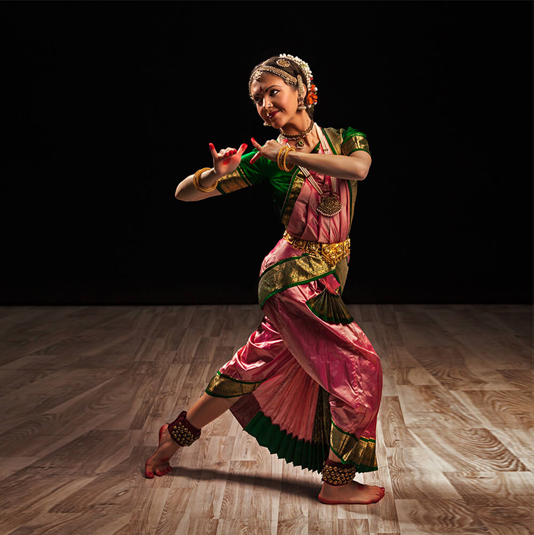
- Bharatanatyam of Tamil Nadu in southern India has grown out of the art of dancers dedicated to temples, and was earlier known as Sadir or Dasi Attam.
- It is the first of India's traditional dances to be refashioned as a theatre art and to be exhibited widely both at home and abroad.
- Bharatanatyam rests on principles of performance and an aesthetics set down in classics such as Bharata's Natyashastra. It has a rich repertoire of songs in Telugu, Tamil and Sanskrit.
- The present-day format of a Bharatanatyam recital, as well as a valuable part of its musical compositions, were created by the famed ‘Tanjore Quartet’ of the nineteenth century: the brothers Ponniah, Chinnaiah, Sivanandam and Vadivelu.
- Bharatanatyam has a highly evolved language of Nritta, abstract dance, and Nritya which unfolds the narrative. The themes have a wide range spanning human and divine love, and are generally classed under the rubric of shringara (romantic love) and Bhakti (devotion).
- The music of Bharatanatyam belongs to the Carnatic system of southern India. The musicians accompanying a dance recital include at least one vocalist, a Mridangam (drum)-player, and a flutist or violinist or Veena (lute)-player.
- The group also includes a Nattuvanar, or dance conductor, who recites the dance syllables as he plays a pair of small bronze cymbals.
B) Manipuri Dance, Manipur
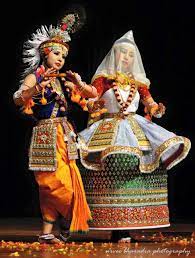
- Manipuri dance, evolved in Manipur in north-eastern India, is anchored in the Vaishnava faith of the Meiteis, or people of the Manipur valley.
- The predominant theme of Manipuri dance is devotion, and the rich lore of Radha and Krishna lends it episodic content.
- Manipuri dance is introverted and restrained compared to most other dances of India – the artist never establishes eye contact with the audience.
- Mudras or hand-gestures are subtly absorbed in the flow of the movement overall. The facial expression is subdued and never exaggerated. These features are evident even in the more vigorous masculine dances.
- Jagoi and cholom are the two main divisions in Manipur’s dance, the one gentle and the other vigorous, corresponding to the Rasya and Tandava elements described in Sanskrit literature.
- The jagoi element is predominant in Ras Leela and similar votive performances. In such dances the legs are bent and the knees held close together.
- The Pung, a drum, and flute are the principal instruments used in Manipuri dance.
C) Kathak, Northern India
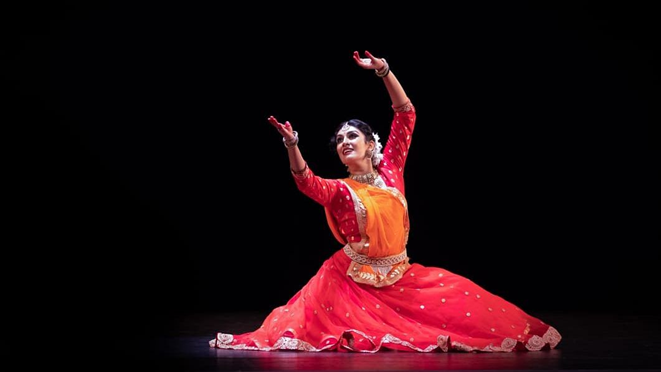
- Kathak is the principal dance of northern India, and is widely practised in Uttar Pradesh, Rajasthan, Delhi, Madhya Pradesh, and even parts of western and eastern India today.
- It is believed to be connected with the narrative art of Kathakara’s or story-tellers who have expounded the scriptures, the epics Ramayana and Mahabharata, and puranic literature to the lay masses since ancient times.
- Expanding and refining its movement and vocabulary of expression, this art possibly transited to a courtly milieu in medieval India, and achieved its finest flowering under Mughal rule.
- Later, in the nineteenth century, the princely courts at Lucknow, Jaipur, Raigarh, and other places emerged as leading centres of Kathak dance. During the twentieth century, as training and practice of Kathak increasingly received the support of public institutions, choreographic work involving groups of dancers has claimed more space in Kathak practice.
- Kathak's thematic content today straddles various worlds, even though the lore of Krishna still has a special place in its repertoire.
- The music of traditional Kathak consists of the Thumri and other lyrical song-forms, and the essential musical instruments are the Tabla, Pakhawaj, and Sarangi. The sitar and other plucked strings are also associated with Kathak performed today.
- The Thumri is a popular genre of Hindustani music characterized by a lyricism that gives expression to various shades of romantic love. It acquired a special connection with Kathak dance in the court of Wajid Ali Shah at Lucknow in the nineteenth century.
- Typically, a Thumri has a short text of two to four lines which are repeated sometimes using a sthayi-antara form. The singer extracts and projects new shades of meaning from the reiteration of each line of text by vocal inflections and melody changes—a process known as bol banana.
- The Thumri is highly ornamented, employing melodic filigree and tiny turns of voice (murki) and shakes. It is usually set to a slow tala, with occasional lively drum interludes called laggis. There are several different styles of singing thumri, the most prominent being the Punjabi, Purabi (of Lucknow), and Benaras styles.
D) Odissi Dance, Orissa
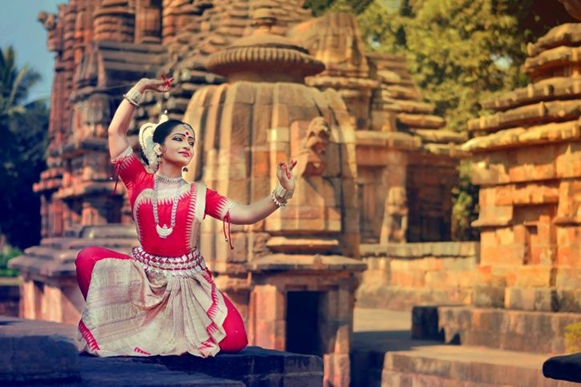
- Odissi dance has its origins in Orissa in eastern India, where in its rudimentary form it was performed as part of temple service by ‘maharis’ or female temple servants.
- The traditional dance was remoulded as a theatre art towards the middle of the twentieth century. In its remodelled form, Odissi dance has spread quickly across the country.
- The Vaishnava faith of Orissa is intrinsic to Odissi dance and the lore of Krishna and Radha supplies its content. Love lyrics from Jayadeva's Sanskrit work Gitagovindam therefore have pride of place on the Odissi dance repertoire.
- Codified footwork of ‘Pada bheda’, gaits and walks termed ‘chalis’, and spins or ‘bhramaris’ are other components of the technique of Odissi dance.
- Odissi in its performance appears sculpturesque, particularly in its serpentine ‘tribhangi’s’ or the firm, square stance called chowk. The movements are soft and graceful.
- The dancer is supported by a singer, a drummer who plays the Pakhawaj, flute and Sitar. The dance conductor also sits with the musicians reciting the rhythmic syllables and keeping time with his cymbals.
E) Kathakali
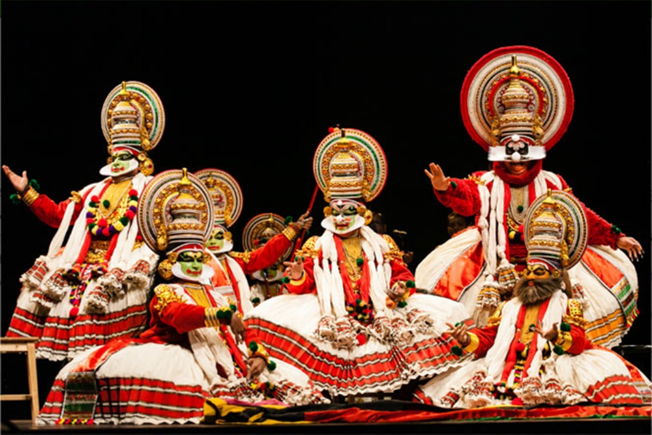
- Kathakali or ‘story play’ took shape in Kerala in southern India in the seventeenth century under the patronage of the prince of Karnataka.
- Stories from the Ramayana and Mahabharata provide the content of most Kathakali plays, which have come down to us in a steady stream over three centuries.
- The faces of actors are painted according to the type of character they represent – green for heroes, kings, and divinities, red and black for the evil and fierce, etc. The main feature of the costume is a large, billowing skirt for male characters and various elaborate headdresses
- The actor’s performance in a Kathakali plays is completely speechless: the ‘libretto’ is sung by two singers on the stage who keep time on gong and cymbals, while a pair of drummers also on the stage play the Chenda. The story is enacted using a vocabulary of facial expressions and hand-gestures.
- A traditional performance of Kathakali starts in the evening after preliminaries that include an invocatory drumming on the Maddalam, and concludes only at daybreak.
F) Mohiniattam
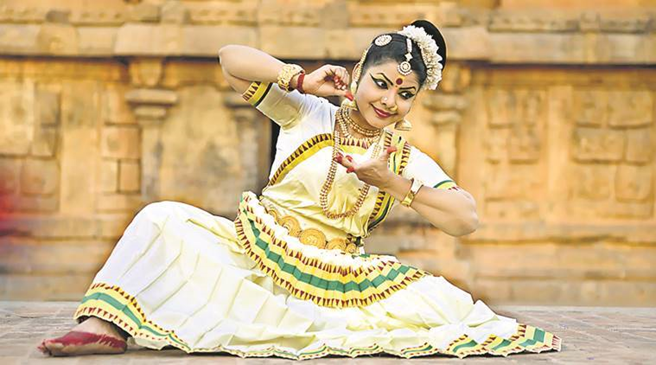
- Mohiniattam, which belongs to Kerala in southern India, takes its name from the mythic enchantress Mohini. It is dance of feminine grace, and has grown out of performances connected with Kerala’s temples.
- The prince Swati Tirunal of Travancore, a patron of arts and an artist himself, was one of the chief architects of the dance in the nineteenth century and composed a large repertoire of songs which accompany the performance.
- Characterized as it is by femininity, Mohiniattam has no heavy steps or rhythmic tension: the footwork is gentle, soft, and sliding. The dancer’s body rises and falls with an easy grace, with the emphasis mainly on the torso. Restraint in movement is the hallmark of the dance.
- Mohiniattam uses rhythms that are special to Kerala: the rhythmic syllables used are those of the Maddalam, a drum which provides accompaniment for female roles in the Kathakali theatre. The main percussion instruments in the performance are the Edakka.
G) Kuchipudi
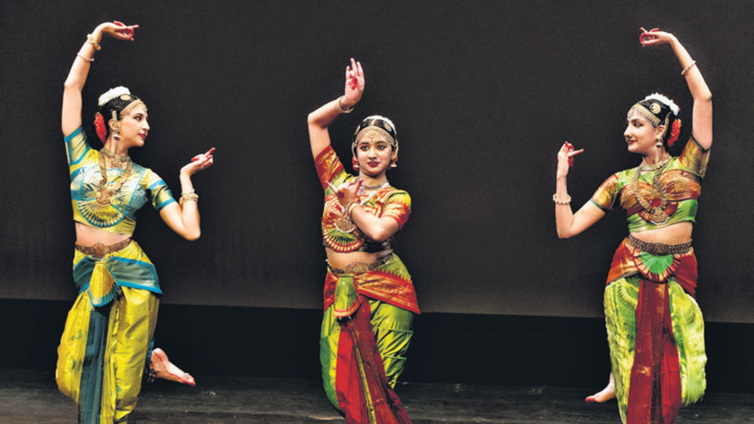
- Kuchipudi, one of the major dance forms of India was originated from Andhra Pradesh, where it grew largely as a product of Bhakti movement beginning in the 7th Century AD.
- Kuchipudi derives its name from the village Kuchelapuram, where it was nurtured by great scholars and artists who built up the repertoire and refined the dance technique.
- The Kuchipudi is a dance-drama of Nritta, Nritya and Natya. The Nritta consists of teermanams and jatis, the Nritya of Sabdams, and the Natya of acting with Mudras for the songs. Nritta encompasses steps and movements in the form of patterns of dance which, though ornate in themselves, have no meaning to convey.
- Kuchipudi, combines speech, Abhinaya (mime) and pure dance. The Kuchipudi dancer is a multiple person on the stage and this multiplicity is achieved by the swift change of mime which depends more on the combination of the naturalism of the dramatic content and the symbolism of the poetic intensity of feeling of an episode. The consequence of this is the emphasis laid on the dynamics of movement and expressionism of feeling.
- Kuchipudi dance is accompanied by Carnatic Music. Kuchipudi today is performed either as a solo, duet or a group presentation, but historically it was performed as a dance drama, with several dancers taking different roles.
H) Sattriya Dance
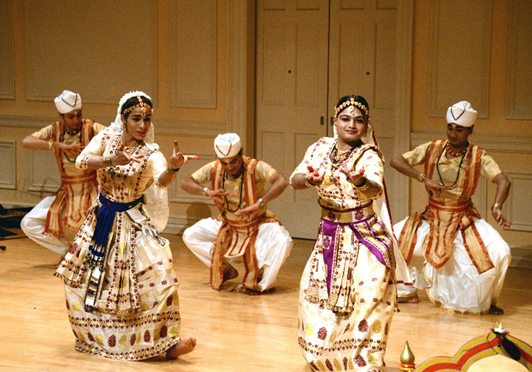
- ‘Sattriya dance’ refers to the body of dance and danced drama developed in the sattras or monasteries of Assam since the sixteenth century, when the Vaishnava faith propagated by the saint and reformer Shankaradeva (1449-1586) swept the land.
- It is a distinct genre within the fold of classical Indian dance, with an evolved language of hand gesture (hasta), footwork (pada karma), movement and expression (Nritta and Abhinaya), and a repertoire centered on devotion to Krishna.
- Since the latter part of the twentieth century, when this monastic art was embraced by artists outside the sattras, Sattriya dance has been practised also as a modern theatre art.
- Typically, it may start with an invocation to the deity, Krishna or Rama, followed by the dance of the sutradhar, the conductor of performances in the sattra. The dancer may then present a mix of pure dance and abhinaya based upon the vast literature of the sattras, the items chosen to give full play to her accomplishment in these departments of the dance.
- Ramdani, Chali, Mela Nach and Jhumura offer scope for Nritta, while abhinaya may be explored in the form of Geetar Nach. Group dances are also common in traditional and modern Sattriya dance, and these may be prefaced with a brief musical ‘interlude’ on drums, the Gayan Bayan, performed by a group of musicians.
- Entirely original dance dramas in the mould of the traditional Sattriya dance are also presented on the stage today. The musical component of the dance is rich and varied in its rhythmic, melodic, and lyrical aspects.
I) Chhau dance (Eastern India)
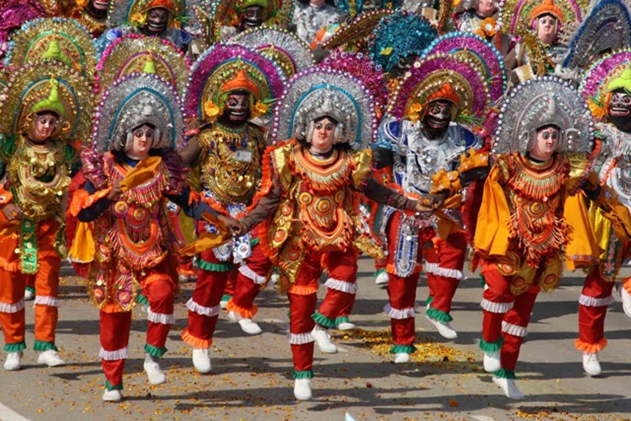
- The Chhau dance of Eastern India - Orissa, Jharkhand, and West Bengal – is a blend of martial traditions, temple rituals, and folk and popular performance of this region.
- Episodes from the epics Mahabharata, Ramayana, Puranas, traditional folklore, local legends and abstract themes through the medium of dance and a music ensemble that consists primarily of indigenous drums.
- In its traditional context, the dance is intimately connected with the festivals and rituals of this region. Important among these is the Chaitra Parva celebrated in the month of April. The month of Chaitra celebrates the advent of spring and the start of the harvesting season.
- The melody is interwoven and is provided by reed pipes like the Mohuri, Turi-Bheri and Shehnai. Though vocal music is not used in Chhau, the melodies are based on songs from the Jhumur folk repertoire, the devotional Kirtan, classical Hindustani 'ragas', and traditional Oriya sources. Dhol, Dhumsa, Nagada, Chadchadi and Jhanj provide accompaniment to Chhau dance.
Some famous folk dances of India
Bhangra: Bhangra is a popular folk dance of Punjab, which is performed during the harvest season. It is a high-energy dance that is accompanied by the beat of the dhol, a traditional Punjabi drum. Bhangra is characterized by its energetic movements and lively music.
Garba: Garba is a traditional folk dance of Gujarat, which is performed during the Navratri festival. It is a circular dance that is performed by both men and women. Garba is characterized by its graceful movements and colorful costumes.
Dandiya: Dandiya is another folk dance of Gujarat, which is also performed during the Navratri festival. It is a lively dance that is performed by couples who hold small wooden sticks called dandiyas. Dandiya is characterized by its fast-paced movements and rhythmic music.
Ghoomar: Ghoomar is a traditional folk dance of Rajasthan, which is performed by women. It is a circular dance that is characterized by its graceful movements and colorful costumes. Ghoomar is accompanied by traditional Rajasthani music.
Lavani: Lavani is a popular folk dance of Maharashtra, which is performed by women. It is a high-energy dance that is characterized by its fast-paced movements and rhythmic music. Lavani is often performed during festivals and other celebrations.
Bihu: Bihu is a folk dance of Assam, which is performed during the Bihu festival. It is a high-energy dance that is accompanied by traditional Assamese music. Bihu is characterized by its fast-paced movements and colorful costumes.
TO ACCESS ALL THE GENERAL STUDIES NOTES CLICK ON: https://ensureias.com/notes


